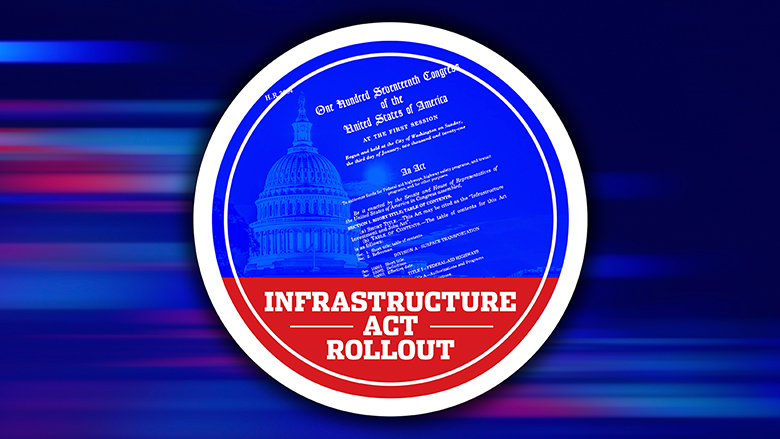As the Biden administration continues to release additional funds from the Infrastructure Investment and Jobs Act, White House officials also are intensifying their focus on ways to speed the paths of IIJA-funded projects through the sometimes long and daunting permit-approval process.
Construction industry officials and many federal lawmakers have long complained that the federal permit-review and approval process takes much too long, running up project costs.
Administration officials on May 10 unveiled a "permitting action plan ” that outlines steps agencies can take to expedite environmental and other reviews for a project's road to a federal permit.
[View White House fact sheet on action plan here.]
The plan has five main components:
--Coordinating permitting activities among multiple federal agencies;
--Setting clear goals for reviews and permitting schedules and deadlines;
--Connecting early in the process with states, localities and tribal nations, which are responsible for contracting for the lion's share of IIJA projects;
--Making federal agencies more responsive by developing tools to help guide stakeholders through the project-review process;
--Increasing agencies’ personnel levels and other resources to handle assessments of projects’ effects on the environment and local communities, including their impact on climate change.
Brenda Mallory, chairwoman of the White House Council on Environmental Quality (CEQ), said in a May 10 briefing for reporters, “These five elements will result in better permitting outcomes, enhanced predictability for project sponsors and increased accountability across federal agencies.”
Jason Miller, the Office of Management and Budget’s deputy director for management, said, “The action plan is designed to swiftly deliver the benefits and infrastructure investment to the American people, to well design projects that promote rather than compromise our environment.”
A key challenge will be balancing a desire to accelerate reviews with the administration's strong backing for environmental protections.
ASCE Comment
The American Society of Civil Engineers welcomed the administration's announcement. ASCE President Dennis D. Truax said in a statement that the plan is "a step in the right direction to ensure that projects can be delivered on time and on budget, while maintaining the rigorous environmental review process."
Miller said that to flesh out the details of the action plan, OMB and CEQ will issue guidance documents that will “lay out some of the nuts and bolts” of the permitting initiative.
Samantha Silverberg, the White House’s deputy infrastructure implementation coordinator, said, “Delivering projects on time, on task and on budget is our top priority.” She noted that to help reach that goal, the infrastructure act includes new mechanisms and expands established entities that deal with reviews and approvals.
For example, the statute provides additional authority for the Federal Permitting Steering Council, established in 2015, which seeks to bring agencies together early in the permitting process for large, complex projects.
For some pre-IIJA projects, Silverberg said the council’s efforts have “led to faster and more predictable timelines for project sponsors and investors and outcomes for communities."
As an example, she points to the permitting for a project that predates the IIJA, the South Fork wind farm in federal waters 35 miles off the eastern end of Long Island, N.Y. The Environmental Protection Agency issued the final air permit for the 130-MW project on Jan. 18.
New in the infrastructure act is a provision to codify a Trump administration executive order instituting a "one federal agency" policy. It sets a goal of completing National Environmental Policy Act reviews generally within two years.
Silverberg also gave an update on the pace of distributing IIJA funds. She said that in the nearly six months since the IIJA's Nov. 15 enactment, more than $110 billion of its estimated $1.2 trillion in funding has been announced and is moving to states, localities and other entities.
She also said that funding-availability notices for an additional $50 billion have been issued. Those notices apply to such programs as Dept. of Transportation discretionary grants, for which states and localities must apply and compete.
Mallory also discussed the permitting plan at a May 11 Senate Committee on Environment and Public Works hearing. She said the initiative would “bring together the best tools available, to take advantage of what we know has worked in the federal government to get decisions done in a way that is both appropriate but recognizes what our values are.”
As a result, Mallory added, “You get the projects, but you also get them done well.”
Administration's NEPA Revision
Several committee members expressed concerns that other policies such as the administration’s two-phase revision of the National Environmental Protection Act (NEPA) reviews may ultimately complicate project permitting processes rather than shorten them.
Phase 1, finalized in April, restores requirements for indirect and cumulative-impact reviews, including a project’s effects on greenhouse gas emissions and climate change, and allowing agencies to work with communities to mitigate or avoid environmental harms by analyzing alternative approaches.
At the hearing, Mallory offered no details on the second phase of the NEPA revamp, but insisted that the effort aims to ensure all potential project impacts are considered.
Narrowing the impact evaluation too much, she said, “is just setting us up for failure." Mallory added, "Our focus is on making sure agencies have the tools to do the necessary analysis but support them it in ways that they can do it in a time-efficient manner.”
Story updated on 5/12 with reporting on Senate hearing and American Society of Civil Engineers comment.





